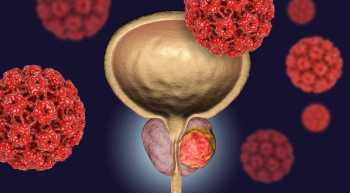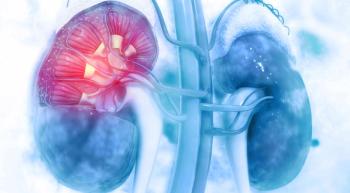
Brexu-cel is effective in treating patients with relapsed/refractory B-cell acute lymphoblastic leukemia, real-world data shows.
Russ Conroy is an Assistant Editor for CancerNetwork. He grew up in Hillsborough, New Jersey, and graduated from Rutgers University-New Brunswick in 2022.
On the weekends, he likes to unwind by playing video games with friends, tailgating at Rutgers football games with his family, or building his music collection with a visit to Princeton Record Exchange.

Brexu-cel is effective in treating patients with relapsed/refractory B-cell acute lymphoblastic leukemia, real-world data shows.

Patients with extensive-stage small cell lung cancer tended to have better PFS and OS with complete consolidative radiotherapy compared to incomplete consolidative radiotherapy.

Nivolumab plus AVD outperformed brentuximab vedotin plus AVD in patients with advanced-stage classical Hodgkin lymphoma.

An investigational formula of panobinostat called MTX110 may improve outcomes in patients with recurrent glioblastoma.

The addition of T4001, an investigation cancer vaccine, to avelumab did not improve progression-free survival vs avelumab alone in cervical and anogenital tumors.

Weekly MR-Linac adaptive radiotherapy limited exposure to normal brain tissue in patients with high-grade glioma.

Adding talazoparib to enzalutamide improved survival in patients with metastatic castration-resistant prostate cancer.

A supplemental biologics license application was submitted for telisotuzumab vedotin for the treatment of metastatic EGFR wild-type nonsquamous non–small cell lung cancer.

The addition of nivolumab to radiotherapy significantly improved freedom from biochemical recurrence in patients with high-grade prostate cancer.

ODAC voted against the use of PD-L1 expression as a predictive biomarker in gastric cancers.

Belantamab plus VRd led to promising outcomes in newly diagnosed transplant-eligible myeloma, study results showed.

Consolidation durvalumab improved survival across subgroups of patients with limited-stage small cell lung cancer based on factors associated with prior prophylactic cranial irradiation and concurrent chemoradiotherapy use.

Nivolumab plus ipilimumab improved health-related quality of life and reduced symptom burden in patients with microsatellite instability–high/mismatch repair–deficient mCRC.

Patients with relapsed/refractory multiple myeloma who also had a lower tumor burden were more likely to derive deeper responses to idecabtagene vicleucel.

Triplet therapies containing belantamab mafodotin, pomalidomide, and dexamethasone may address an unmet need for relapsed/refractory multiple myeloma.

Recent data from a phase 3b trial support venetoclax as a CLL treatment option for those with or without B-cell receptor–associated kinase inhibitor treatment.

Results from the CARTITUDE-2 trial support cilta-cel in patients with multiple myeloma, which addresses the unmet needs of these patients, an expert presented.

All patients treated with CAR T-cell products are recommended to be monitored life-long for the risk of secondary malignancy, according to the FDA.

Patients with locally advanced or metastatic urothelial cancer treated with enfortumab vedotin plus pembrolizumab experienced a reduction in the risk for disease progression or death vs chemotherapy.

Criteria for progression-free and overall survival endpoints in patients with endometrial cancer with mismatch repair proficient disease were not met.

Stereotactic ablative body radiotherapy in primary renal cell cancer may be a treatment approach with an acceptable adverse effect profile and with minimal impact on renal function.

The use of nivolumab plus chemotherapy as a standard frontline treatment has been supported by recent data from the phase 3 CheckMate 649 trial for patients with gastric, gastroesophageal junction, and esophageal adenocarcinoma.

Simple hysterectomy was shown to reduce the incidence of urinary incontinence vs radical hysterectomy for low-risk cervical cancer.

Cancer teams, including oncology nurses, can make conscious choices to potentially alleviate the disparities that persist in hypofractionation, toxicity, and cardiac doses in radiotherapy for Black and Asian patients with breast cancer.

Although frontline treatment with lenvatinib plus pembrolizumab improved ORR and PFS, it did not improve OS when compared with placebo in patients with head and neck squamous cell carcinoma.

It may be feasible to use brexucabtagene autoleucel for the treatment of patients with relapsed/refractory B-cell acute lymphoblastic leukemia with central nervous system involvement.

Stereotactic ablative radiotherapy with standard-of-care therapy improved progression-free survival in patients with oligoprogressive non-small cell lung cancer, although the benefit was not seen in those with oligoprogressive breast cancer.

All prespecified patient subgroups with metastatic urothelial cancer showed a clinical benefit with sacituzumab govitecan plus pembrolizumab in cohort 3 of the phase 2 TROPHY-U-01 trial.

The use of perioperative tislelizumab plus neoadjuvant chemotherapy has been supported by findings from the phase 3 RATIONALE-315 study as a treatment for resectable stage II to IIIA non–small cell lung cancer.

Cabozantinib plus atezolizumab may be a new treatment option for patients with metastatic castration-resistant prostate cancer whose disease progressed on novel hormonal therapy.